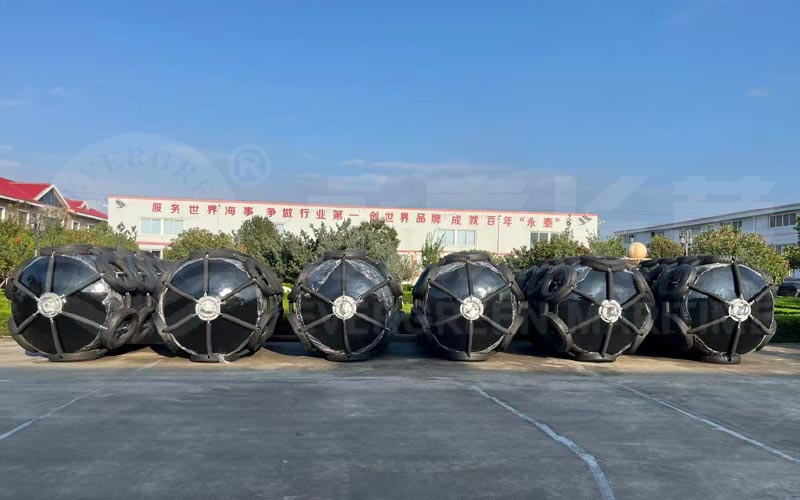To select the fenders with the right type and right size might be a difficult task for some end-users, this paragraph will give you a specific idea of how to do it properly.
Performance Factors
• Energy Absorption Capacity: High-quality foam fenders should possess efficient energy absorption capabilities. They typically utilize lightweight, highly elastic closed-cell foam materials, such as polyurethane or expanded EVA. When a vessel berths, these fenders can absorb impact energy through compressive deformation. Their energy absorption capacity can reach 1.2 – 1.5 times that of pneumatic fenders, and they can maintain structural stability even when compressed by 60%. For instance, when large oil tankers and container ships berth, foam fenders can effectively reduce the structural stress on the vessel hull, preventing hull deformation or dock damage caused by excessive reaction forces. You can evaluate their energy absorption performance by referring to the product’s energy absorption data and practical application cases.
• Reaction Force: The reaction force refers to the force exerted by the fender on the vessel when it is compressed. Excessive reaction force can cause damage to the vessel hull and the dock. Foam fenders generally have relatively low reaction forces. The reaction force coefficient of traditional DA-type rubber fenders is usually 60 – 80 kN/m, while that of foam fenders can be as low as 40 – 60 kN/m, representing a reduction of about 30%. When selecting, you need to choose fenders with an appropriate reaction force based on the type of vessel and berthing requirements.
• Stress Dispersion: Good stress dispersion can prevent local stress concentration, extending the service life of both the fender and the vessel and dock. The closed-cell structure of foam fenders enables them to evenly disperse stress when compressed, offering better stress dispersion than some traditional fenders.

Product Structure and Quality
• Foam Core: The foam core is a key factor reflecting the performance of foam fenders. Closed-cell foam cores should be selected. Meanwhile, depending on different expansion ratios, the foam density will vary. You need to communicate with the manufacturer based on actual application situations. A high-quality foam core should be highly elastic, have low density, and possess good compressive properties.
• External Coating: If the fender has an external coating, the quality and thickness of the coating are crucial as they can resist damage caused by friction. For example, a polyurethane coating can disperse forces. Additionally, pay attention to the structural arrangement of the tire cord layer.
• Central Axis (if applicable): For foam fenders with a central axis, the material and strength of the central axis determine the service life of the fender. A properly sized and strong central axis can significantly enhance the overall cost-effectiveness of the product.
Applicable Scenarios
• Vessel Type: Different types and sizes of vessels have varying requirements for fenders. For example, large oil tankers and container ships require fenders with good energy absorption performance and low reaction forces, while small vessels have relatively lower requirements. You can select appropriate fenders based on factors such as the vessel’s tonnage, size, and berthing speed.
• Dock Environment: The structural form of the dock (such as old-style docks and frame-type docks), tidal range conditions, and the corrosiveness of seawater all affect the selection of fenders. For instance, at docks with large tidal ranges, fenders with floating capabilities and installation positions not restricted by tidal ranges are required. In highly corrosive seawater environments, fenders with acid and alkali resistance and corrosion resistance should be chosen.
Other Factors
• Specifications and Dimensions: Foam fenders come in various specifications. You need to select appropriate dimensions based on actual needs. Consider parameters such as the diameter and length of the fender to ensure it is compatible with the structures of the vessel and the dock.
• Color and Markings: In some scenarios, fenders may need to have specific colors or marking functions to meet safety warning or identification requirements. The exterior color of some foam fenders can be customized according to requirements.
• Installation Method: Common installation methods include chain suspension and flange connection. When selecting, consider the ease of installation and compatibility with the structures of the dock and the vessel.
• Service Life and Maintenance Cost: High-quality foam fenders can have a service life of 10 – 15 years and do not require inflation maintenance. Some models also incorporate modular designs, allowing for the separate replacement of damaged components, which can reduce maintenance costs. When selecting, comprehensively consider the product’s service life and maintenance costs.
• Supplier Reputation: Choose big and professional suppliers, for example, Qingdao Evergreen Maritime Co., Ltd(https://www.maritime-group.cn/products/foam-filled-fenders/), with a good reputation and rich experience. They can provide reliable products and offer professional technical support and after-sales service during installation, use, and maintenance. You can evaluate their reputation by checking the supplier’s qualification certificates, customer reviews, and successful cases.
